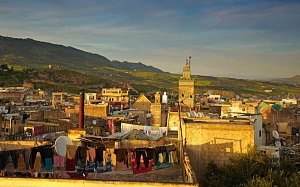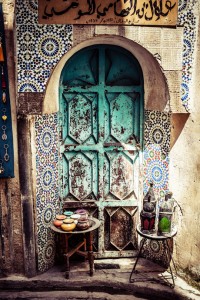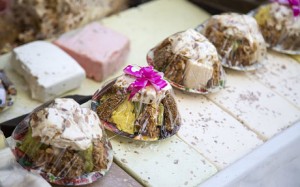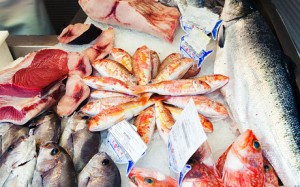The Telegraph
By Nigel Tisdall
Picture: AP

With some 10,000 alleys, it’s easy to get lost in Fes
An entertaining food tour gives Nigel Tisdall an insight into life within the hypnotic, labyrinthine souks of Fes
“I still get lost,” Mehdi Bennani admits as he accompanies me through the ancient heart of Fes. With its 13 mighty gates, eight miles of sandstone walls, pricked with holes like shortbread, and some 10,000 alleys, I’m not surprised.
Just north of the Middle Atlas Mountains, this former Moroccan capital and imperial city is home to the mother of all medinas, dating from the ninth century. A World Heritage site, it is the largest car-free urban area in the world, where 270,000 Fassis dwell in an enclosed space the size of London’s Richmond Park – and it is quite acceptable to yell, “Move your ass!”
Our guide is Houssam Laassiri, ever-smiling chef at Palais Amani, an enchanting 14-room riad on the medina’s northern edge. Born within its time-scarred walls, he knows its secret squares and dog-leg shortcuts inside out, and leads us Pied Piper-like through the maze as part of a half-day cookery course that will teach us how to prepare classic Moroccan dishes such as harira soup, baghrir (Berber pancakes) and fish tajine. Mehdi has come along to translate, clearly relishing the chance to slip away from the reception desk and show us his home town.
It’s hard to fathom why Houssam stops at some stalls rather than others, but our straw shopping baskets are soon brimming with vegetables, eggs and herbs, including a gloriously fragrant sheaf of fresh mint that costs all of 14p. The medina presents a beguiling mix of activity and repose, of the sensual and the nauseous. I snatch a photo of a sunlit mountain of peaches, then feel obliged to take another of a fly-dotted camel’s head hanging outside a butcher’s. Men in djellabas doze on piles of carpets while coppersmiths beat out intricate patterns on huge trays. This is the original live/work neighbourhood, filled with backstreet bakers, hole-in-the-wall tailors, street-side classrooms and jovial stallholders overseeing pleasure gardens of dates, spices, fruit and irresistible syrupy pastries.
Back at Palais Amani, we chop and grate and stir, then feast on our dishes in its tree-shaded courtyard decorated with blue and white tiles and plashing fountains. To save time, Houssam has filmed some of the cooking processes on his phone, and we are given recipes, spices and an apron to take home. The real reward, though, is the way this entertaining cook-up provides an insight into life within the medina. We learn how young people such as Mehdi are moving back because it is cheap and has a sense of community, and we have frank discussions about women’s rights, Islamist terrorists and the legacy of the Arab Spring. Given the tragic state of Syria, Fes has become the destination of choice for travellers seeking a genuine, live-chickens-and-all, I’m-totally-lost souk experience. In my view the city offers a far more authentic and atmospheric short break than better-known Marrakesh, which is now swamped with luxury hotels, designer shops, tour buses and conference venues. Hideous Kinky has, sadly, turned into Carrefour.
By contrast, the medina in Fes remains wondrously intense and startling – and nowhere makes this clearer than its star sight, the unremittingly stinking tanneries of Chouwara. Here bare-chested workers toil in the sun treating hides in a colourful array of oversized inkwells that send a defiant up-yours to Health & Safety. “The process is easy, the work hard,” a mellifluous trader opines as we behold this medieval scene from a multi-storey shop where every inch of wall is crammed with leather belts, slippers, bags and clothes. Within 20 minutes, in a time-honoured barter-dance that leaves all parties content, he seduces my wife into buying a bright orange Chanel-ish jacket for £160, haggled down from £250.
Three nights here will be enough for most visitors, possibly longer if you balance this claustrophobic world with a day trip to the nearby Roman ruins of Volubilis and the imperial city of Meknes. Living inside the medina’s tumultuous labyrinth is like swimming underwater – sooner or later you need to come up for air. The mosque, the Jnane Sbil gardens, the alcove at the back of the carpet showroom – every Fassi has their secret spot to escape its relentless pressure.
For us, it is the cool sanctuary of our riad, which can only be entered by banging a big brass ring on its 12ft wooden doors. Once inside its flower-filled patios, where there is a subterranean hammam and calm bedrooms decorated with stained glass, the whirlpool of the medina disappears.
Up on Palais Amani’s capacious roof terrace, guests sip mint tea and examine their hard-won purchases. Aromatic honeys, gilded tea glasses, agave silk scarves, painted pottery bowls… Come sunset, there is a sense of lofty peace that spans the centuries. How many travellers, from the 12th-century Muslim philosopher Averroes to the American writer Paul Bowles, have found a similar content watching hundreds of swifts swooping above the rooftops in a tangerine sky? Of course, the medina has modernised – today there are cashpoints by the hammam and satellite dishes adorn the buildings like flowers facing the sun. The muezzin’s call now competes with the roar of passing scooters, but the storks are still nesting on the city walls as they did 1,200 years ago. Let us hope, inshallah, that Fes stays forever thus.
Getting there
Ryanair (ryanair.com) flies direct to Fes from London Stansted, from £40 return. Airport transfers take 30 minutes and cost around €35 (£27) if arranged through your hotel (that way you’ll find it…), or expect to pay £10 for a taxi to the medina walls.
Where to stay
Riad Alkantara £
Walled gardens and a long spring-fed swimming pool are the standout attractions in this five-suite riad buried deep in the medina. From €155 (£117) with breakfast (00212 5 3574 0292; riadalkantara.com).
Hotel Sahria ££
Opened in April on a hill just outside the medina, this cool and contemporary hotel, below, has 50 rooms set on four floors with a huge infinity pool, French and Moroccan restaurants and a Givenchy Spa. From £140 with breakfast (5 3594 0332; hotelsahrai.com).
Palais Amani £££
A spacious 14-suite riad set on three floors with a tree-filled inner courtyard and friendly staff keen to help guests enjoy Fès. A half-day cookery class costs £88 and you can also learn bread-making and calligraphy. From €190 (£143) with breakfast (5 3563 3209; palaisamani.com).
Lawrence of Morocco (01672 500 555; lawrenceofmorocco.com) offers three nights at Palais Amani from £512 per person, based on two sharing, including flights, breakfast and transfers. An excursion to Volubilis and Meknès costs £72 per person .
Where to eat
Café Clock £
A welcoming travellers’ pit stop near Bab Boujeloud with cosy lounges on multiple levels, plus classes and cultural events. Camel burgers (£7) are popular but there also salads, quiches and reviving juices. No alcohol (00212 5 3563 7855; cafeclock.com).
Dar Hatim ££
“Welcome to our home,” beams Karima. Firmly on the tourist trail, Dar Hatim offers home-cooked Fassi fare in a living room of swirled pattern carpets, embroidered tablecloths and an elaborately carved wooden ceiling. Go for the chicken pie, from £10 for three courses, no alcohol, cash only (5 3563 7836).
Dar Roumana £££
An intimate and enchanting riad restaurant with six candlelit tables set inside a high-walled, tiled courtyard. The Mediterranean cuisine is well executed with two courses from £21, wine is available (5 3574 1637; darroumana.com).
What to see
Three-hour walking tours of the medina with an English-speaking guide can be arranged through your hotel for around £42, excluding entrance fees. They usually start at the western end by the King’s Palace then visit the Jewish quarter, Medersa Bou Inania and the tanneries. Find time for Musée Nejjaarine, a restored fondouk from 1711 that is now a serene wood and crafts museum with a handy salon-de-thé on the top floor, and Palais Glaoui, a massive abandoned palace complete with a green onyx bathroom suite imported from London.
Plan-It Fez (00212 5 3563 8708; plan-it-fez.com), run by a couple of English and Australian “working mums”, can arrange tailor-made tours and insider experiences.
When exploring independently, bear in mind it may be easier to go outside the medina walls and take a petit-taxi to another section – carry a stash of 20 dirham (£1.40) notes to cover such journeys. At night it is common practice for a restaurant to send a guide (without extra charge) to walk you there and back so you don’t get lost.
A 90-minute drive west of Fes, the vast Roman ruins of Volubilis are particularly enjoyable when the spring flowers are in bloom. Day trips usually include a stop at the mausoleum of Moulay Idriss (non-Muslims cannot enter) and Meknès, with its engrossing testimony to the excesses of the 17th-century Sultan Moulay Ismail.
Guides tend to be more affable escort than enlightening expert, so do some background reading. Morocco (Rough Guides; £16.99) includes a detailed chapter on Fes, or see visitmorocco.com.










